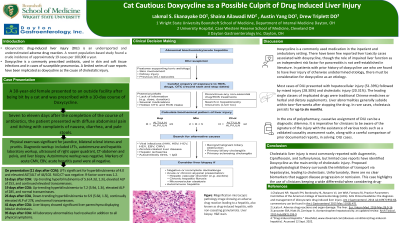Tuesday Poster Session
Category: Liver
P3945 - Cat Cautious: Doxycycline as a Possible Culprit of Drug-Induced Liver Injury
Tuesday, October 24, 2023
10:30 AM - 4:00 PM PT
Location: Exhibit Hall

Has Audio

Lakmal Ekanayake, DO
Wright State University
Dayton, OH
Presenting Author(s)
Lakmal Ekanayake, DO1, Shaina Ailawadi, MD2, Austin Yang, DO1, Drew Triplett, DO3
1Wright State University, Dayton, OH; 2University Hospitals, Cleveland, OH; 3Dayton Gatroenterology, Dayton, OH
Introduction: Doxycycline is a commonly prescribed antibiotic, used frequently in skin and soft tissue infections and pneumonia. A limited series of case reports have implicated doxycycline as the cause of cholestatic injury. In our case, we report our findings for clinical and laboratory trends related to doxycycline-induced liver injury from a patient following a cat bite.
Case Description/Methods: A 30-year-old female who was recently treated for a cat bite presented with abdominal pain and itching. Prior to presentation, she had been treated with a 10-day course of doxycycline. Seven days after the completion of antibiotics, the patient started experiencing symptoms of nausea, diarrhea, and pale stools. 11 days after completion of antibiotics (COA); the patient presented to the outpatient clinic with abdominal pain and pruritus. Physical exam was significant for jaundice, bilateral scleral icterus, and pruritus. Diagnostic workup of abdominal pain included liver functioning enzymes (LFTs), autoimmune and hepatitis laboratory workup, ultrasound of right upper quadrant, computed tomography of abdomen and pelvis, and liver biopsy. Autoimmune workup with anti-nuclear antibody, anti-mitochondrial antibody, and anti-alpha smooth muscle antibody was negative. Markers of acute Cytomegalovirus and Epstein Barr virus and acute hepatitis panel were negative. On presentation, LFTs significant for hyperbilirubinemia of 4.0, AST/ALT of 44/102, and RUQ ultrasound was negative. Initial R-factor score was 1.2. 16 days after COA; LFTs continued to increase with hyperbilirubinemia of 5.6 (4.3 direct, 1.3 indirect bilirubin) alkaline phosphatase (ALP) of 253, and elevated transaminases. 19 days after COA, there was increasing hyperbilirubinemia to 7.2 (5.9 direct, 1.3 indirect), elevated ALP of 285, and normal transaminases. 26 days after COA, LFTs improved, bilirubin decreased to 6.9 (5.6 direct 1.3 indirect), and ALP was 278. 41 days after COA, liver biopsy showcased significant liver parenchyma displaying lobular cholestasis. Lastly, 95 days after COA, all laboratory abnormalities and symptoms had resolved
Discussion: Doxycycline-induced cholestatic injury is a rare entity with limited reports describing doxycycline as the leading culprit of cholestatic injury. The proposed pathophysiology focuses on the inhibition of transport via hepatocytes leading to cholestasis. Our case highlights the importance of clinicians keeping a wide differential when considering drug-induced cholestatic injury.
Disclosures:
Lakmal Ekanayake, DO1, Shaina Ailawadi, MD2, Austin Yang, DO1, Drew Triplett, DO3. P3945 - Cat Cautious: Doxycycline as a Possible Culprit of Drug-Induced Liver Injury, ACG 2023 Annual Scientific Meeting Abstracts. Vancouver, BC, Canada: American College of Gastroenterology.
1Wright State University, Dayton, OH; 2University Hospitals, Cleveland, OH; 3Dayton Gatroenterology, Dayton, OH
Introduction: Doxycycline is a commonly prescribed antibiotic, used frequently in skin and soft tissue infections and pneumonia. A limited series of case reports have implicated doxycycline as the cause of cholestatic injury. In our case, we report our findings for clinical and laboratory trends related to doxycycline-induced liver injury from a patient following a cat bite.
Case Description/Methods: A 30-year-old female who was recently treated for a cat bite presented with abdominal pain and itching. Prior to presentation, she had been treated with a 10-day course of doxycycline. Seven days after the completion of antibiotics, the patient started experiencing symptoms of nausea, diarrhea, and pale stools. 11 days after completion of antibiotics (COA); the patient presented to the outpatient clinic with abdominal pain and pruritus. Physical exam was significant for jaundice, bilateral scleral icterus, and pruritus. Diagnostic workup of abdominal pain included liver functioning enzymes (LFTs), autoimmune and hepatitis laboratory workup, ultrasound of right upper quadrant, computed tomography of abdomen and pelvis, and liver biopsy. Autoimmune workup with anti-nuclear antibody, anti-mitochondrial antibody, and anti-alpha smooth muscle antibody was negative. Markers of acute Cytomegalovirus and Epstein Barr virus and acute hepatitis panel were negative. On presentation, LFTs significant for hyperbilirubinemia of 4.0, AST/ALT of 44/102, and RUQ ultrasound was negative. Initial R-factor score was 1.2. 16 days after COA; LFTs continued to increase with hyperbilirubinemia of 5.6 (4.3 direct, 1.3 indirect bilirubin) alkaline phosphatase (ALP) of 253, and elevated transaminases. 19 days after COA, there was increasing hyperbilirubinemia to 7.2 (5.9 direct, 1.3 indirect), elevated ALP of 285, and normal transaminases. 26 days after COA, LFTs improved, bilirubin decreased to 6.9 (5.6 direct 1.3 indirect), and ALP was 278. 41 days after COA, liver biopsy showcased significant liver parenchyma displaying lobular cholestasis. Lastly, 95 days after COA, all laboratory abnormalities and symptoms had resolved
Discussion: Doxycycline-induced cholestatic injury is a rare entity with limited reports describing doxycycline as the leading culprit of cholestatic injury. The proposed pathophysiology focuses on the inhibition of transport via hepatocytes leading to cholestasis. Our case highlights the importance of clinicians keeping a wide differential when considering drug-induced cholestatic injury.
Disclosures:
Lakmal Ekanayake indicated no relevant financial relationships.
Shaina Ailawadi indicated no relevant financial relationships.
Austin Yang indicated no relevant financial relationships.
Drew Triplett indicated no relevant financial relationships.
Lakmal Ekanayake, DO1, Shaina Ailawadi, MD2, Austin Yang, DO1, Drew Triplett, DO3. P3945 - Cat Cautious: Doxycycline as a Possible Culprit of Drug-Induced Liver Injury, ACG 2023 Annual Scientific Meeting Abstracts. Vancouver, BC, Canada: American College of Gastroenterology.
